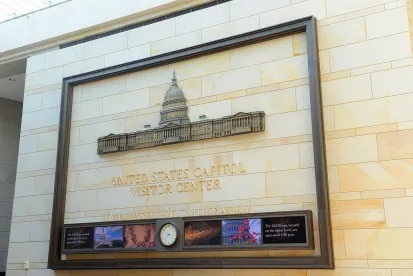Federal contractors and subcontractors were left with a lot to consider last Friday (September 24, 2021), when the Safer Federal Workforce Task Force issued COVID-19 Workplace Safety Guidance implementing President Joe Biden’s Executive Order 14042, “Ensuring Adequate COVID Safety Protocols for Federal Contractors” (Order).
The Order and Guidance direct executive departments and agencies, including independent establishments subject to the Federal Property and Administrative Services Act (40 U.S.C. § 102(4)(A)), to ensure covered “contracts and contract-like instruments” include a clause requiring the contractor to comply with all COVID-19 safeguard guidance (Guidance) for contractor workplace locations published by the Safer Federal Workforce Task Force (Task Force) for the duration of the contract. Covered contractors and subcontractors (at any tier) will be obligated to incorporate the Clause into lower-tier subcontracts. According to the Guidance, “[T]hese safeguards will decrease the spread of SARS-CoV-2, the virus that causes COVID-19, which will decrease worker absence, reduce labor costs, and improve the efficiency of contractors and subcontractors performing work for the Federal Government.”
Unlike executive orders covering the federal contractor minimum wage and paid sick leave, there will be no federal agency regulations promulgated to implement the Order. Aside from the Clause, and a Federal Acquisition Regulation (FAR) provision to be issued by the FAR Council by October 8, the Guidance, which includes FAQs, is the sole source of the requirements for federal contractors.
Several federal court lawsuits already have been filed challenging the legality of the Order and seeking a stay of the Order pending a full adjudication on the merits. No court yet has blocked the Order and Guidance requirements from moving forward.
Guidance Requires Vaccines, Masking, Distancing
The Guidance dictates that covered employees (defined by the Guidance and discussed below) must be “fully vaccinated,” unless legally entitled to an accommodation due to a disability or religious belief, practice, or observance.
Covered employees and site visitors must follow Centers for Disease and Prevention (CDC) guidance for masking and physical distancing. Covered contractors must require the following for all individuals in covered workplaces:
-
Wear appropriate masks consistently and correctly (over mouth and nose).
-
Wear appropriate masks in any common areas or shared workspaces (including open floorplan office space, cubicle embankments, and conference rooms).
-
For individuals who are not fully vaccinated, wear a mask in crowded outdoor settings or during outdoor activities that involve sustained close contact with other people who are not fully vaccinated, consistent with CDC guidance.
Significantly, in addition to contracts specifically covered by the Order (discussed in more detail below and in our previous client alerts), the Guidance “strongly encourages” agencies to incorporate a clause requiring compliance with the Guidance to contracts that are not covered by or directly addressed by the Order, including contracts for “for the manufacturing of products.” This directive is at odds with the Order’s coverage provisions (discussed below), including the exclusion of subcontracts solely for the provision of products.
Key Effective Dates
By October 8, 2021, the FAR Council and executive agencies will publish the Clause to be incorporated into contracts. The Order’s effective date is November 14, 2021, at which point the Clause will begin to appear in new contracts. The Guidance directs, “Between October 15 and November 14, agencies must include the clause in the solicitation and are encouraged to include the clause in contracts awarded during this time period but are not required to do so unless the solicitation for such contract was issued on or after October 15.”
Covered employees must be fully vaccinated by December 8, 2021. This date appears to align with the effective date of the requirements for new contracts. The Guidance specifies that after that date, all covered employees must be vaccinated by the first date of performance on a newly covered contract and by the first day of the period of performance on an exercised option, or extended or renewed contract when an existing contract is modified to incorporate a clause requiring compliance with the Guidance. If an agency has an “urgent mission-critical need” for covered employees to work on a covered contract before becoming fully vaccinated, the agency may approve a limited exception of a 60-day grace period for full vaccination.
Contracts and Contract-Like Instruments are Defined as …
Matching the proposed regulations for the $15 minimum wage for federal contractor employees, the term “contract and contract-like instrument” is defined as any agreement between two parties enforceable by law. The Guidance states, “This definition includes, but is not limited to, a mutually binding legal relationship obligating one party to furnish services (including construction) and another party to pay for them.” This definition omits any reference to products or supplies. Examples include, but are not limited to:
… any procurement actions, lease agreements, cooperative agreements, provider agreements, intergovernmental service agreements, service agreements, licenses, permits, or any other type of agreement, regardless of nomenclature, type, or particular form, and whether entered into verbally or in writing. The term contract shall be interpreted broadly as to include, but not be limited to, any contract within the definition provided in the FAR at 48 CFR chapter 1 or applicable Federal statutes. This definition includes, but is not limited to, any contract that may be covered under any Federal procurement statute. Contracts may be the result of competitive bidding or awarded to a single source under applicable authority to do so. In addition to bilateral instruments, contracts include, but are not limited to, awards and notices of awards; job orders or task letters issued under basic ordering agreements; letter contracts; orders, such as purchase orders, under which the contract becomes effective by written acceptance or performance; exercised contract options; and bilateral contract modifications. The term contract includes contracts covered by the Service Contract Act, contracts covered by the Davis-Bacon Act, concessions contracts not otherwise subject to the Service Contract Act, and contracts in connection with Federal property or land and related to offering services for Federal employees, their dependents, or the general public.
However, simply because an agreement is a “contract or contract-like instrument” does not mean it is covered by the Order or the Guidance. The Order covers a defined set of contracts and contract-like instruments.
Contract Coverage
The Guidance defines contracts covered by the Order, and those excluded, in the same way as the Order itself at Section 5:
(a) This order shall apply to any
-
new contract;
-
new contract-like instrument;
-
new solicitation for a contract or contract-like instrument;
-
extension or renewal of an existing contract or contract-like instrument; and
-
exercise of an option on an existing contract or contract-like instrument,
if:
(i) it is a procurement contract or contract-like instrument for services, construction, or a leasehold interest in real property;
(ii) it is a contract or contract-like instrument for services covered by the Service Contract Act, 41 U.S.C. 6701 et seq.;
(iii) it is a contract or contract-like instrument for concessions, including any concessions contract excluded by Department of Labor regulations at 29 CFR 4.133(b); or
(iv) it is a contract or contract-like instrument entered into with the Federal Government in connection with Federal property or lands and related to offering services for Federal employees, their dependents, or the general public;
(b) This order shall not apply to:
(i) grants;
(ii) contracts, contract-like instruments, or agreements with Indian Tribes under the Indian Self-Determination and Education Assistance Act (Public Law 93–638), as amended;
(iii) contracts or subcontracts whose value is equal to or less than the simplified acquisition threshold, as that term is defined in section 2.101 of the Federal Acquisition Regulation [currently $250,000];
(iv) employees who perform work outside the United States or its outlying areas, as those terms are defined in section 2.101 of the Federal Acquisition Regulation; or
(v) subcontracts solely for the provision of products.
Whereas the proposed regulations for the federal contractor $15 minimum wage omit coverage for procurement contracts for services other than those covered by the Service Contract Act (SCA), the Guidance does not. Thus, service providers (prime and subcontractors) may be covered by clauses requiring compliance with the Guidance, if incorporated by into their contracts, even if they do not have any contract covered by the SCA. Moreover, as discussed above, other contracts not covered by the Order, including those specifically excluded under Section 5, may be modified by contracting agencies to incorporate a clause requiring compliance with the Guidance.
Thus, while contract coverage is clear in some instances (SCA and procurement contracts for construction for examples) some federal contractors simply may not know with any certainty whether they will have a covered contract until a Clause requiring compliance with the Guidance appears in a contract. That uncertainty may make preparation difficult, at best, for federal contractors with contracts not explicitly covered by the Order.
Guidance Defines Covered Contractor Employees, Covered Contractor Workplaces Expansively, Including Employees Working Remotely
The Guidance defines “covered contractor employees” and “covered contractor workplaces” broadly in its definitions and FAQs:
Covered contractor employee – means any full-time or part-time employee of a covered contractor working on or in connection with a covered contract or working at a covered contractor workplace. This includes employees of covered contractors who are not themselves working on or in connection with a covered contract.
Covered contractor workplace – means a location [including outdoor workplaces – FAQ 7] controlled by a covered contractor at which any employee of a covered contractor working on or in connection with a covered contract is likely to be present during the period of performance for a covered contract. A covered contractor workplace does not include a covered contractor employee’s residence.
Q11: How does this Guidance apply to covered contractor employees who are authorized under the covered contract to perform work remotely from their residence?
A: An individual working on a covered contract from their residence is a covered contractor employee, and must comply with the vaccination requirement for covered contractor employees, even if the employee never works at either a covered contractor workplace or Federal workplace during the performance of the contract. A covered contractor employee’s residence is not a covered contractor workplace, so while in the residence the individual need not comply with requirements for covered contractor workplaces, including those related to masking and physical distancing, even while working on a covered contract.
Thus, coverage is determined primarily by assessing whether federal work on – or even in connection with – a covered contract is being performed at each of a federal contractor’s locations. If a single employee at any location is working on or “in connection with” a covered contract, all employees at that location and visitors to that location are covered and subject to the Guidance.
An employee works “in connection with” a covered contract if she “perform[s] duties necessary to the performance of the covered contract, but [is] not directly engaged in performing the specific work called for by the covered contract. These functions may include, for example, “human resources, billing, and legal review, perform work in connection with a Federal Government contract.”
As for remote workers working on or in connection with a covered contract, they must be vaccinated, regardless of whether they ever work at or visit a covered location. However, remote workers while at their residences need not comply with masking and distancing requirements.
All Campus Buildings and Employees May Be Covered
For federal contractors with campus environments, but only one building where federal work is performed (on or in connection with), Guidance FAQ 9 states that the requirements apply to all the buildings, employees and visitors at each building,
… unless a covered contractor can affirmatively determine that none of its employees in or at one building, site, or facility will come into contact with a covered contractor employee during the period of performance of a covered contract … including interactions through use of common areas such as lobbies, security clearance areas, elevators, stairwells, meeting rooms, kitchens, dining areas, and parking garages.
Proof of Vaccination Required – Attestation by Employees Does Not Suffice
Covered contractors must review covered employee’s documentation to prove vaccination status including:
-
A copy of the vaccination record or card issued by a pharmacy, health care provider, public health or state immunization agency
-
Digital copies of such records including a photograph, scanned image or PDF
The Guidance makes clear that an attestation by a covered employee that the employee is fully vaccinated does not comply with the requirements.
Contractors Must Designate a Person Responsible for Implementation and Compliance and Provide Notice
Covered contractors must designate a person or persons to implement the Guidance and “ensure that covered contractor employees [and visitors] comply with the requirements … related to the showing or provision of proper vaccination documentation.” Implementation must include:
… communicating the required workplace safety protocols and related policies by email, websites, memoranda, flyers, or other means and posting signage at covered contractor workplaces that sets forth the requirements and workplace safety protocols in this Guidance in a readily understandable manner.
Next Steps for Federal Contractors
Federal contractors and subcontractors have a lot of work in front of them: determine the likelihood they will have covered contracts, and, if so, prepare for Order and Guidance mandates. Federal contractors should review their existing contracts to determine if those contracts are within the scope of coverage such that they should anticipate a contract modification (by a FAR Clause for contracts subject to the FAR or by contract clause for non-FAR-contracts) on or before the contract is extended, renewed, or an option year exercised. In addition, contractors should monitor their contracts that are outside the scope of the Order for action by contracting agencies modifying those contracts to include a Clause requiring compliance with the Guidance.
Contractors will need to consider the following:
-
Identifying covered workers and workplaces
-
Accommodations requests
-
Designating person or persons to coordinate implementation and compliance with the Guidance
-
Implementing a process for reviewing employee vaccine documentation to verify it is one of the types of documents permissible to prove vaccine status
-
Posting and distributing required notices
-
Flowing down the FAR Clause or clause requiring compliance with the Guidance to all subcontractors, except those solely for the provision of products
-
Assessing whether covered workers are in a state or location in which mandatory vaccinations for employees is prohibited, although the Guidance states the requirements supersede state or local laws that would seek to prohibit compliance.
Many federal contractors and subcontractors will be subject to not only the Order, but also to the Department of Labor’s Occupational Safety and Health Administration’s (OSHA) Emergency Temporary Standard (ETS) requiring all employers with 100 or more employees to ensure all employees are fully vaccinated or able to produce a negative COVID-19 test result on at least a weekly basis, and comply with masking and social distancing requirements. Indeed, the Guidance at FAQ 20 states that covered federal contractors must comply with the Guidance independent of the requirements of OSHA’s upcoming ETS.







 />i
/>i

